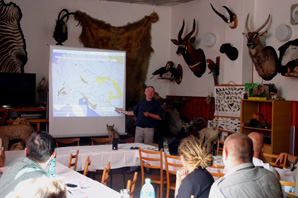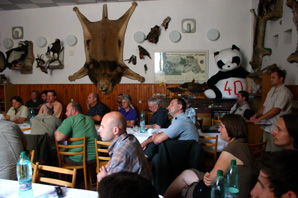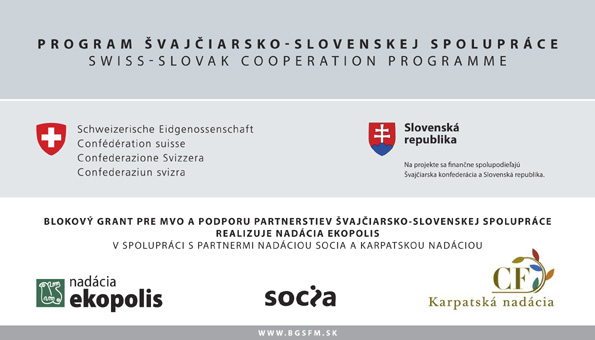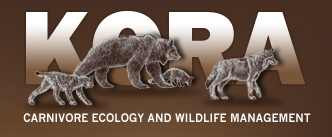Living with Carpathian Spirits
The aim of the project is the conservation of lynx populations in Slovakia and Switzerland through scientific monitoring, applied research and environmental awareness raising in the context of practical protection and reintroduction management. The project is supported through the Swiss-Slovak Cooperation Programme; the partners are SWS, KORA and Bojnice Zoo.
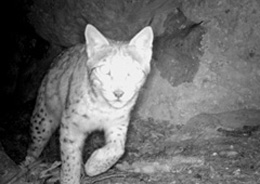
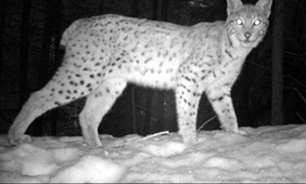
Working visit to Switzerland
21-25 October 2013
Together with colleagues from Albania, Macedonia and Ukraine we took part in the Lynx research and conservation training workshop at our partner organization KORA in Muri/Bern in Switzerland with support of the Council of Europe/Bern Convention. Lectures dealt with the issue of conflicts between stakeholders and large carnivores, GIS habitat modelling, use of camera traps, databases and archiving various data and health status and genetics of lynx. Together with Dr. Breitenmoser and Dr. Marie-Pierre Ryser-Degiorgis we visited Juraparc, where rehabilitated lynx will be housed. This programme was important particularly due to establishment of a similar approach and rehabilitation facility for the Carpathian lynx in Bojnice Zoo.
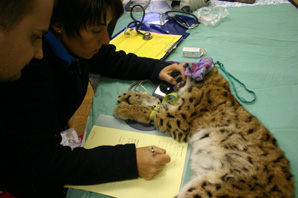
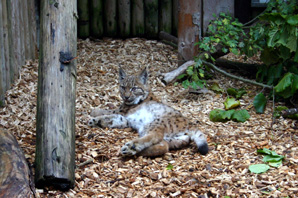
Braňo and Robin attended a health check-up of a juvenile lynx at FTWI - Centre for Fish & Wildlife Medicine, University of Bern. Jakub, Peter and Braňo participated in identifying a lynx kill and subsequent deployment of a live-capture system. Jakub and Braňo also took part in an autopsy and x-ray examination of a juvenile lynx at FTWI with Dr. Ryser-Degiorgis; the rest of the team went on an excursion aimed at finding a lynx kill. Discussions focused especially on the design of stratified monitoring within the Living with Carpathian Spirits project as well as approaches to analyzing the data we obtain.
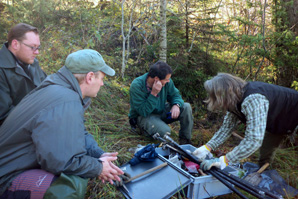
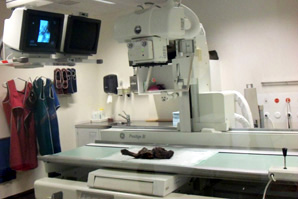
Monitoring starts in Veľká Fatra NP
15-16 October 2013
Together with colleagues Juraj Žiak, Ľudo Remeník and Maja Apfelová from Veľká Fatra National Park authority we have started extensive monitoring with the use of camera traps in Veľká Fatra NP in order to identify the best places with the highest probablity of lynx occurrence for systematic monitoring of Carpathian lynx this winter. Potential sites were visited on the basis of the long-term experience of our colleagues in monitoring lynx within the national park.
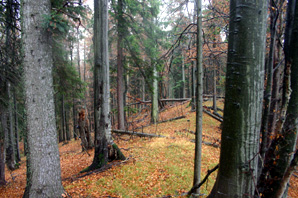
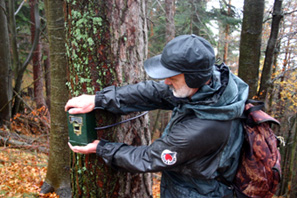
First results from Štiavnické Mountains
21 September 2013
Extensive monitoring using camera traps means making use of automatic traps at particular spots throughtout the year, season or period of time or using them opportunistically at kill sites and the like. This type of monitoring is helpful in selecting sites for more intensive (systematic) monitoring. Field workers involved in extensive as well as intensive monitoring must regularly check camera traps and recover images, change batteries, clean away snow or clear vegetation whose movement could trigger the cameras, check the technical state and functioning of the equipment, its installation, relocation and removal as well as identify suitable sites and locations etc. Since the beginning of the project Living with Carpathian Spirits extensive monitoring has so far documented three different individual lynx in Štiavnické Mountains Protected Landscape Area.
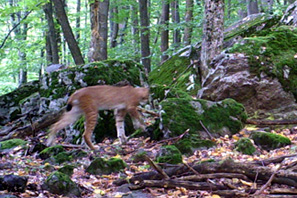
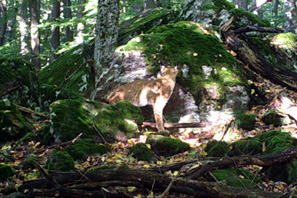
Cybertracker certification
29-30 September 2013
During these two days we had the chance to become certified wildlife trackers. Two expert assessors, Cybertracker network members David Moskowitz and his colleague Casey McFarland, came to test us and evaluate our knowledge, experience and skills in the field. These true masters were able, in a short period of time and in unfamiliar territory, to identify many tracks and signs of the presence of animals. Our task was to identify and sometimes also describe in detail animal activity. They asked about signs that many people would not even notice: subtle scratches in tree bark, an old depression in mud, excavated earth, the exact number of footprints or identifying which of the animal's feet made them. Our team was successful: we all received Track & Sign certificates.
Expanding international cooperation
7 August 2013
From 18 July to 7 August we hosted a visit to Slovakia by representatives of our project partners from Swiss organization KORA Dr. Urs Breitenmoser, Christine Breitenmoser-Würsten and colleagues. They presented important aspects of the currently running project Living with Carpathian Spirits at an international seminar on lynx held on 19 July and we subsequently completed several field trips together in the Štiavnické Mountains and Veľká Fatra National Park, which are the reference areas for the project. As part of training young experts and sharing know-how, Dr. Breitenmoser demonstrated a gentle method for catching lynx at kill sites for future research. An important part of the stay was visiting 'trapper' Štefan Zátroch, who spent 33 years trapping lynx in Slovakia and so contributed significantly to the success of the rescue programme in Europe in 1960–1990.
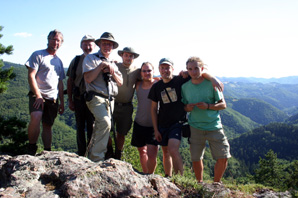
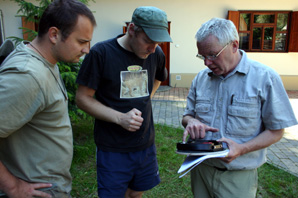
KORA's visit also focused on developing and extending international cooperation between European research institutions and scientists. As part of this activity we held meetings with representatives of the Academy of Sciences in Kiev, Skole Beskydy and Uzhansky National Parks (Ukraine), Bieszczady National Park (Poland), Poloniny National Park and Zvolen Technical University (Slovakia). During these meetings we discussed possibilities for extending applied research in the areas mentioned in view of different legislative environments and land ownership rights within each country. The aim of developing this collaboration is to include the Eastern Carpathians as an important part of active monitoring. Such monitoring would provide valuable information on the current status of predators and other species and would significantly advance the development of sustainable managamement of protected species and their habitats.
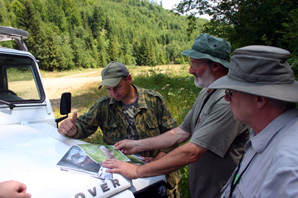
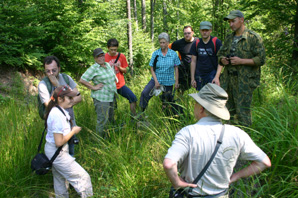
International seminar on lynx
19 July 2013
Experts dealing with research and conservation of the lynx in Slovakia gathered together at Bojnice Zoo School for an international seminar on 19 July. Dr. Urs Breitenmoser and Dr. Christine Breitenmoser-Würsten from Swiss organisation KORA as well as of the IUCN Cat Specialist Group were our esteemed hosts. In their presentations they repeatedly emphasised the importance of detailed research on the population in Slovakia as the source in the past for the reintroduction of several lynx populations in Europe. We learned about the history and current status of the lynx in Europe as well as the system and results of monitoring and genetic research in Switzerland. Participants were shown in detail how we will conduct research on lynx during the project Living with Carpathian Spirits: using camera traps and capture-mark-recapture techniques to identify individuals and determine abundance with statistics. Jakub Kubala of Zvolen Technical University and at the present time also an employee of Bojnice Zoo and SWS presented the aims of the project in the Štiavnické Mountains and Veľká Fatra National Park. Among the 36 participants besides locals and guests from Switzerland were also colleagues from the Czech Republic.
